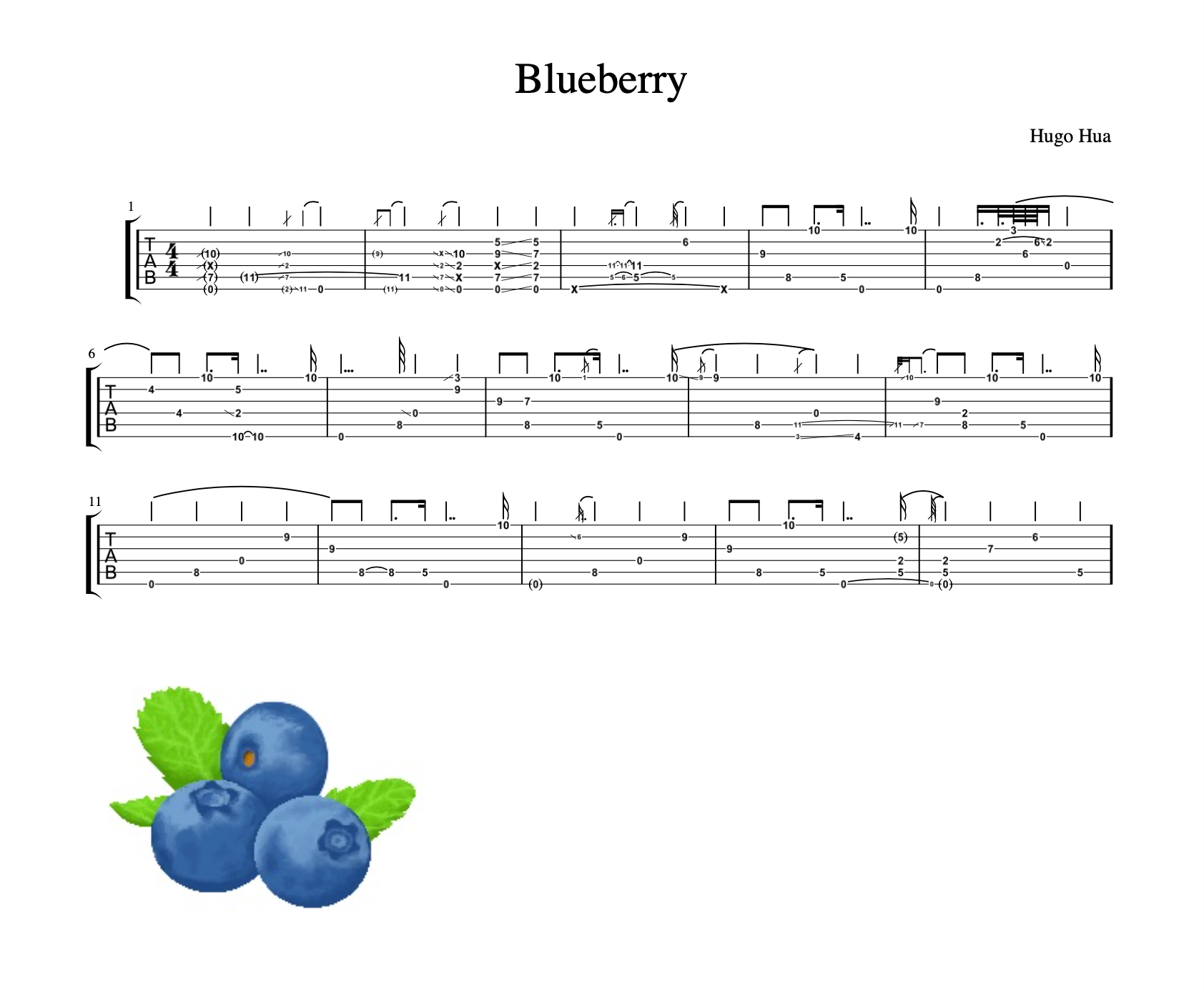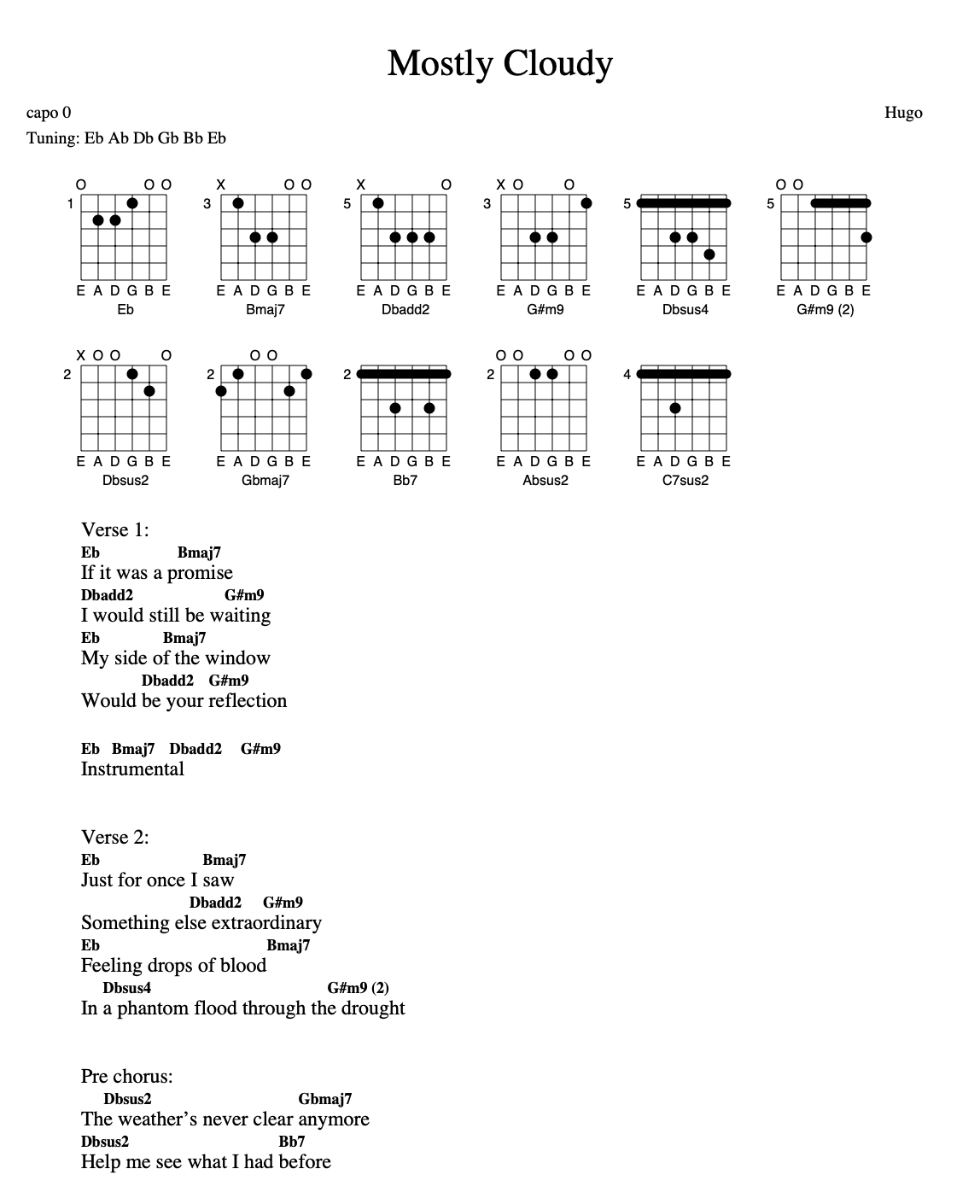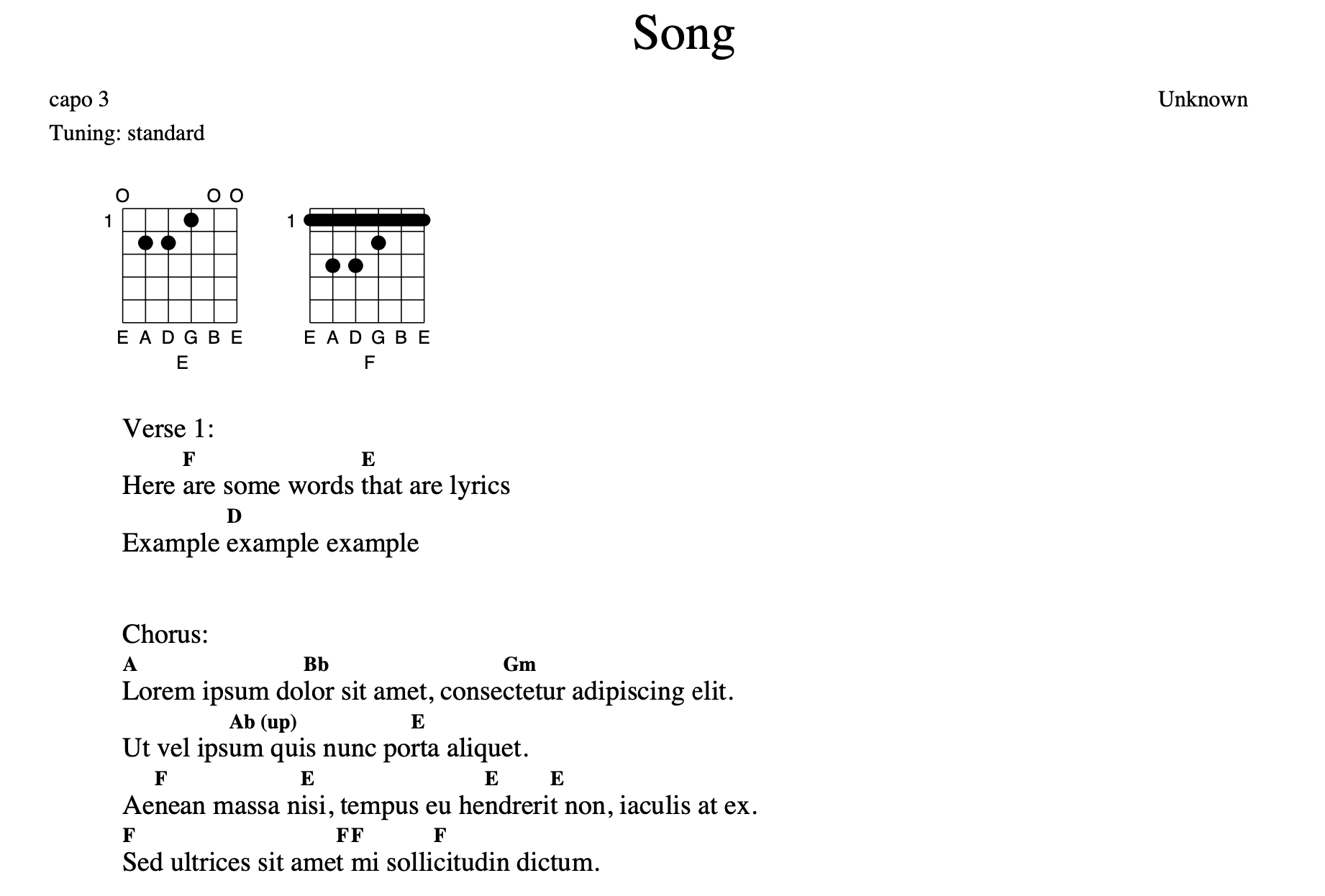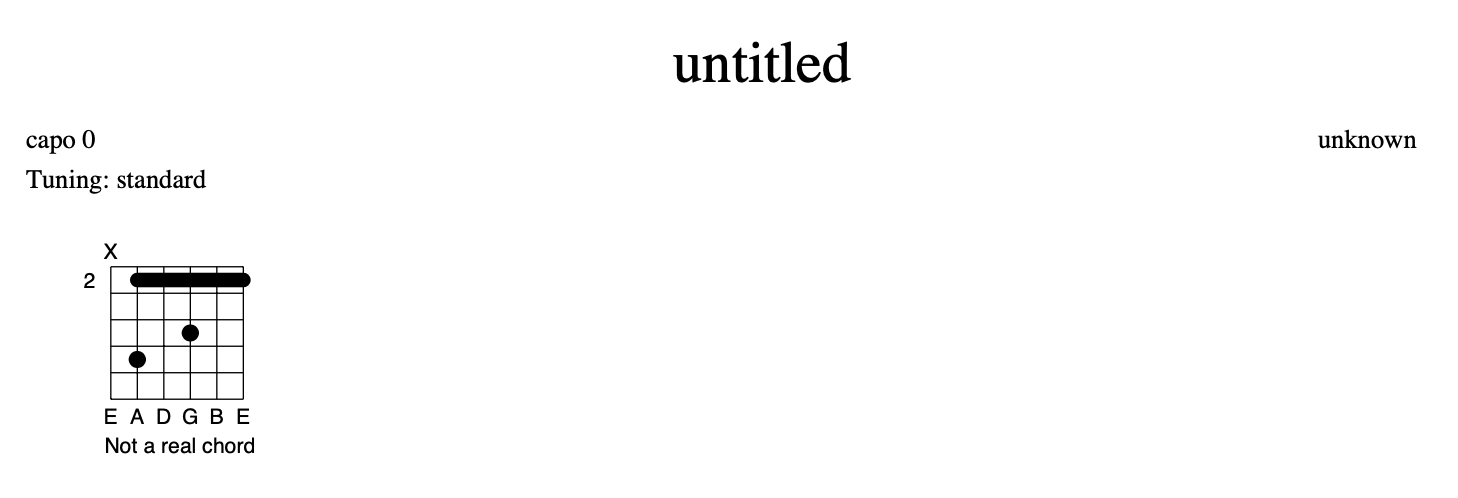Create Guitar Tabs
With a simple syntax, blueberry lets you focus on the music, and not on annoying UIs! Blueberry comes with two modes: score mode and tab mode. Score mode is used to create guitar tablature for fingerstyle playing, while tab mode is used to create more traditional guitar tabs, with lyrics, chord charts, and chord placements.


Usage
In order to run the program, you need to have .NET and Ghostscript installed. Follow the instructions for downloading and setup.
Mac
Download the packages above and clone this repo into an easily accessible location.
Running Within the Blueberry Folder
-
The quickest way to run the program is directly in the cloned repo. Open terminal, and navigate to the lang folder within blueberry.
cd path-to-folder/blueberry/lang -
Create a new file to write your code in. I suggest using the .blb extension for ease-of-use, but any extension works.
-
Run using dotnet. It will create a .ps file with the specified name.
dotnet run <mode> <filename> <output filename> -
Use ps2pdf, a command line tool from Ghostscript, to convert the postscript file to a pdf. If you get an error, you may need to add ghostscript to your PATH variable.
ps2pdf -dNOSAFER <file>.psRunning From Separate Folder
-
To run the program on files in a separate folder, I suggest writing a custom script to do the job for you. Follow this link for instructions on how to set up a file with custom scripts. Once created, add the following, replacing PATHTOFILE with the path to wherever you cloned the blueberry folder:
function pspdf() { ps2pdf -dNOSAFER $1.ps open $1.pdf } function blbscore() { if [[ "$#" == 0 ]]; then echo 'Usage: blbscore <file with code> <name of output file>' return 0 fi if [ -z "$2" ] then OUTFILE='score' else OUTFILE=$2 fi cwd=$(pwd) cd ~/PATH_TO_REPO dotnet run score $cwd/$1 $OUTFILE pspdf $OUTFILE rm $OUTFILE.ps mv $OUTFILE.pdf $cwd cd $cwd } function blbtab() { if [[ "$#" == 0 ]]; then echo 'Usage: blbtab <file with code> <name of output file>' return 0 fi if [ -z "$2" ] then OUTFILE='tab' else OUTFILE=$2 fi cwd=$(pwd) cd ~/PATH_TO_REPO dotnet run tab $cwd/$1 $OUTFILE pspdf $OUTFILE rm $OUTFILE.ps mv $OUTFILE.pdf $cwd cd $cwd }Now, you can create files anywhere on your computer, and run it using
blbtab <filename> <outputFile>orblbscore <filename> <outputFile>!
Windows
Download the packages above and clone this repo into an easily accessible location. In addition, make sure you have Virtual Studio Code.
The instructions for running within the blueberry folder should be the same as for Mac users. Use the terminal function within VsCode. In addition, check out this post for how to use the ghostscript functions in the terminal. I’m not familiar with scripting on Windows and how to create a script to run the program from other folders.
Score-Mode Documentation
Basic Syntax
-title Example
-composer Person
-key c
-time 4-4
-capo 1
1:
1f4/sls
3g#
5d8/sli
(5f 6x)8
4e4/sle
2:
2e16
<2f#16 3g16 4g16/har>8
2a16
6bb2
1f8/gra
2a4

Each file begins with options that control certain aspects of the tab. They begin with a -, followed by the option name, and the chosen parameter. Next, each measure begins with the measure number, a colon, and the notes on separate lines with a tab (or at least a space).
Options
Here are the valid options:
-title Blueberry
-composer Hugo Hua
-arranger Unknown
-key d#m
-time 4-4
-capo 2
-tuning E-A-D-G-B-E
The title, arranger, and composer can be whatever you choose, and the capo is an integer.
Key
Valid keys are:
- c
- cm
- c#
- c#m
- cb
- d
- dm
- db
- d#m
- e
- em
- eb
- ebm
- f
- fm
- f#m
- f#
- g
- gm
- g#m
- gb
- a
- am
- a#m
- ab
- abm
- b
- bm
- bb
- bbm
Notes that are entered will be automatically changed based on the key chosen.
Time
Time signatures are of the format <top>-<bottom>. The first number can be a number between 1-32, or 64, and the second number can be 1, 2, 4, 8, 16, 32, or 64.
Notes and Rests
There are several basic note types: single notes, rests, groups, and tuplets.
Single notes follow the format <string number><pitch><OPTIONAL rhythm><OPTIONAL properties>. Here are some examples:
1e4
5f#/gra
6x8../gra/slu
Rests follow the format r<OPTIONAL rhythm>
r
r8
r16..
Grouped notes allow for multiple notes to be played at the same time. They follow the format (<note>+)<OPTIONAL rhythm><OPTIONAL group-properties> where <note> is composed of <string number><pitch><OPTIONAL group-member-properties>. I know, it looks crazy, but it’s not that bad! Properties work differently with grouped notes, because some properties must be applied to an individual note within the group, while others are applied to the entire group. See the properties section for more info.
(1e 2e 3e)4
(4f#/har 6dn)16/gra
(3dn 4fb 6x/par)
Tuplets allow for more complex rhythms and syncopation. They follow the format <<note>+><rhythm>, where <note> is a single note, group note, or rest. The rhythm at the end denotes the total rhythm of the entire tuplet. Note that the final rhythm is required for tuplets.
<4d8 2f16>4
<6d r 1f (5f 3d)>8
<1f#8/har 2dn4/par/sli/sls (4f#/sld 1x/har)16./gra/sle>32.
Pitch
The following are valid pitches:
- c
- c#
- cb
- cn
- d
- d#
- db
- dn
- e
- e#
- eb
- en
- f
- f#
- fb
- fn
- g
- g#
- gb
- gn
- a
- a#
- ab
- an
- b
- b#
- bb
- bn
- x
Notes with an n are natural notes, which differ from regular notes in that the key signature will not change them. The x represents a percussive note rather than a pitch; it shows up as an “X” rather than a fret number. Using the pitches, key signature, and capo, the program calculates the fret for that note on the given string. The default is the lowest possible fret, but there is a property that can raise frets, which will be explained in the properties section.
Rhythm
Rhythms are denoted with a number after the pitch.
0 = full measure (only for rests)
- 1 = whole note
- 2 = half note
- 4 = quarter note
- 8 = eighth note
- 16 = sixteenth note
- 32 = 32nd note
- 64 = 64th note
Dots . can also be added after the number. The limit is 3 dots for notes of an 8th note or longer, 2 dots on a 16th note, 1 dot on a 32nd note, and no dots are allowed on a 64th note. Rhythms are optional; if omitted, the note will have the same rhythm as the previous note. The default for the first note on the page is one unit of the given time signature. Note: the 0 rhythm can only be used for rests. r0 denotes an empty measure. Another node: if you label a measure as measure 0, it can have less than the required number of beats. This allows for pick up notes at the beginning of the piece.
Comments
Comments can be added in between any notes using the $ symbol. The comment must begin with and end with a $. It will appear directly underneath the note that came before the comment. In addition, hidden comments can be written using the % symbol. These can be written anywhere in a measure, as well as in between measures, and will not appear anywhere in the tab.
-title Comments
-time 4-4
-key c
-composer Hugo Hua
% hello %
0:
1e
$Note$
1e
1:
%Hidden comment%
1f#4
1f#
1e
1d

Properties
Properties allow for symbols, articulations, and customization. This section details all the valid properties.
All properties begin with a / and consist of 3 letters, except ^, which is the property for pushing a note up to the next possible fret position for that note.
Grace Notes
Grace notes are defined with the /gra property. They are otherwise written in the exact same way as regular notes, except that their rhythm will not count towards the measure’s entire rhythm.
-time 2-2
-capo 6
-key ab
-title Grace Notes
-composer Me
1:
1f4
(3d 5fn)4
4g16/gra
3e8
2a
6f4
2:
(1e 2f 4g)8/gra
4x16/gra
5cb/gra
<3f4 5g4 (3a 4f)4>2
3d2

Slurs
Slurs are drawn using the /sls - slur start - and /sle - slur end properties. Each starting slur must be matched with an ending slur on a note further in the tab. Any un-ended slurs will cause an error. In addition, slurs cannot cross; a started slur must be ended before a new one is started.
-time 3-4
-capo 4
-key f#m
-title Slurs
-composer Me
1:
3d/sls
4fn/sle
5g8/sls
3a
2:
1f#4
5x
3d16
4a8
6c16/sle

Hammer On/Off
Hammer notes look like ties, but don’t have to be between the same note. They are defined by /ham
-title Hammer
-time 4-4
-key c
-composer Hugo Hua
1:
1e
1e8
1f#/ham
1g#4
1e
2:
2b
2a8/ham
2b16/ham
2a16
1g#2

Palm Mute
A single note palm mute can be written with /plm. It adds a little ‘PM’ underneath the note.
-title Palm Mute
-time 4-4
-key c
-composer :D
1:
1f#/plm
3e8
1f#
6g#4
5d
2:
2b
2a8/plm
3f#2/plm
1g16
5ab16

Longer Palm Mute
If you have a palm mute that lasts for a while, instead of typing /plm for each note, use /pl1 and /pl2 for the start and end of a longer palm muted section.
-title Palm Mute
-time 4-4
-key c
-composer :D
1:
1f#
3e8/pl1
1f#
6g#4
5d
2:
2b
2a8/pl2
3f#2
2f16/gra/pl1
1g16
5ab16/pl2

Plucked Notes
Plucked Notes can be either up /plu or down /pld. It draws the squiggly line often used in fingerstyle playing.
-time 3-4
-capo 4
-key f#m
-title Plucked Notes
-composer Me
1:
4d8/plu
(3dn 2a)16/pld
5f16
2c2
2:
1e4
(5f 6a 3g 1f)8./plu
3c16
2d4/pld

Strumming
Strummed notes can be either up /stu or down /std. It draws an arrow that directs the player to strum the notes.
-time 6-8
-capo 1
-key f#m
-title Strummed Notes
-composer Me
1:
6f4
1ab8.
2dn16/stu
<1f16 6d16 (6a 5f 1x)16/std>8
2c8
2:
1d4
5f8
(5c 6c 4c 3c)/stu
2e4

Slides
There are three types of slides. First /sli is a slide between two notes. When added to a note, it creates a slide to the next note in the page on the same string. This second note does not have to come directly after the first, but any unended slide will raise an error. Next, slide up /slu and slide down /sld are added to a single note, and they add a small line facing upwards or downwards, telling the player to begin the note above or below and slide into the specified note.
-time 5-8
-capo 6
-key ab
-title Slides
-composer Me
1:
4e8/sli
5g16
(3a 6d 4f)16
5f8/sld
3d8
2c8
2:
(5f#/slu 6d/sli)8.
1x16/slu
6eb8
4f8
2e8/sld

Parentheses
Parentheses can be added using /par. It is often used for a ghost note which is either optional, or meant to be played quietly or in passing.
-time 7-8
-capo 4
-key bbm
-title Parentheses
-composer Me
1:
5e8/par
1f8
(4d 6f#)
4a4
<2a8 3e8 4bb8>4
2:
5b8./par
2a16
(3f 6dn/par 2bb)8
5g4
1e

Tie
Ties are denoted by /tie. The first note must be followed some time later by another note on the same string, with the same pitch. The second note does not have to be directly after the first, but ties cannot cross.
-time 6-4
-capo 3
-key d
-title Ties
-composer Me
1:
4d2
(5f 1eb 2d#)
6f8
1e#/tie
1e#4
2:
6d8/tie
(4f 6d)
2d/tie
3d
2d1

Harmonics
Harmonics are created with /har. It create a <> around a note, telling the player to play the harmonic. It’s up to you to decide how best to represent the fret vs the where to play the actual harmonic!
-time 2-4
-capo 6
-key f
-title Harmonics
-composer Me
1:
4d8/har
(5g 6g)16
1d16
2f8
<4gn16 5fn16/har (1d 2d 3d/har)16>8
2:
(3a 4f 6an)8
2f16./har
3f#32
4fb4

Higher Fret
To put a note on a higher fret, use /^. For example, an e on string 1 would usually be fret 0, but with this property, it will be the next e up : fret 12.
-time 4-4
-capo 3
-key eb
-title Higher Fret
-composer Me
1:
3d8/^
(4f# 2dn 1gb)4
5gn8
1eb4/^
(2d 3d)
2:
5gb8
2dn4
5f8/^
<6d#8 (2dn/^ 4fn 5x)8 3gn8/^ 2a#8 6d>2

Properties for Grouped Notes
Properties work slightly differently for grouped notes, because some properties are added to the group as a whole, and some are added to an individual note within the group.
Properties for the whole group:
/gra/stu/std/plu/pld/sls/sle
Properties for individual notes:
/par/sld/sli/slu/tie/har/^
Changing Key, Capo, Time Signature
The options used at the beginning of the document (key, capo, time in particular) can be used in between measures as well.
Key
-title Key Change
-time 4-4
-key c
-composer Mystery
1:
1f
1f
1f
1f
-key d
2:
1f
1f
1f
1f

Capo
-title Capo Change
-time 4-4
-key c
-composer Mystery
1:
1b
1b
1b
1b
-capo 3
2:
1b
1b
1b
1b

Time
-title Time Change
-time 4-4
-key c
-composer Mystery
1:
2b
1b
3b
2b
-time 3-4
2:
5b
4b
1b

Tab-Mode Documentation
Basic Syntax
-title Song
-composer Unknown
-capo 3
[
title: E
2-2
3-2
4-1
]
[
title: F
barre: [
fret: 1
strings: 1-6
]
2-3
3-3
4-2
]
Verse 1:
Here /F/are some words /E/that are lyrics
Example /D/example example
Chorus:
/A/Lorem ipsum do/Bb/lor sit amet, conse/Gm/ctetur adipiscing elit.
Ut vel ips/Ab-(up)/um quis nunc po/E/rta aliquet.
Ae/F/nean massa n/E/isi, tempus eu he/E/ndreri/E/t non, iaculis at ex.
/F/Sed ultrices sit ame/F/t /F/mi solli/F/citudin dictum.

Options
Just like in score mode, there are a number of valid options.
-title Tab
-composer Hugo
-tuning standard
-capo 2
-key a
Chord Charts
All chords begin with a set of brackets, inside which are 3 parts: the title, a list of barres, and a list of spots. Each barre contains information on what fret the barre is, and what strings it covers (1 is the low E, 6 is the high E). Spots are of the form <string>-<fret>. The fret can also be an X, which will show up on the chart as an X on top of the string (means do not play this string). Any string that is not touched by a spot or a barre will be open be default. Also note that the maximum difference between the lowest and highest fret in one chart is 4.
[
title: Not a real chord
barre: [
fret: 2
strings: 2-6
]
2-5
4-4
1-X
]

Lyrics and Chord Placement
When writing lyrics, they will appear exactly as written, with the same whitespace and linebreaks, except for when line or page wraps are needed. Chords can be placed at specific locations using two slashes, with the name of the chord in the middle /F/. If you put any spaces inside the slashes, weird things could happen, so to avoid this, use dashes instead of whitespace. It will be converted automatically.
Here are /F/some co/E/ol lyr/F-major/ics with chords in them!
